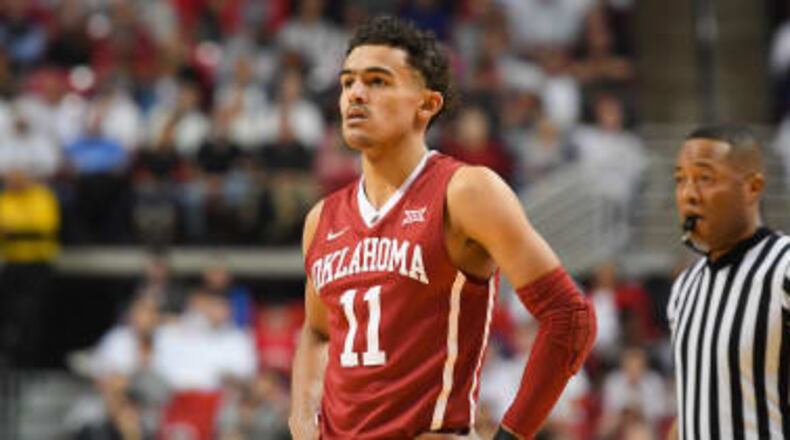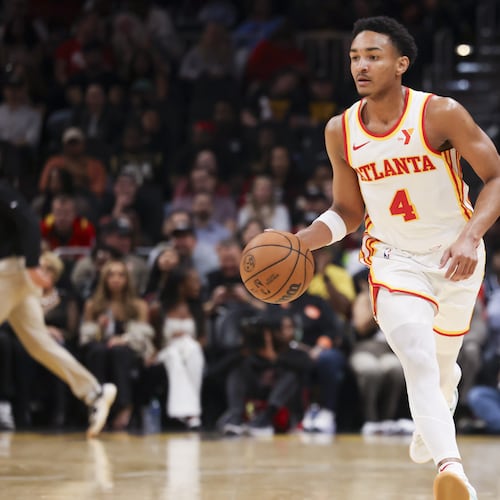Part of Jeff Peterson’s responsibilities as Hawks assistant general manager is to oversee the team’s scouting process. That’s a particularly important role this year as the Hawks own the No. 3 draft pick in addition to Nos. 19, 30 and 34.
I recently sat down with Peterson to get his thoughts on eight top prospects in the 2018 draft: Deandre Ayton, Luka Doncic, Marvin Bagley III, Jaren Jackson Jr., Mo Bamba, Michael Porter Jr., Wendell Carter Jr. and Trae Young. Over the last several days I’ve posted some lightly-edited transcripts of those conversations.
Previous entries: Deandre Ayton, Luka Doncic, Marvin Bagley III, Jaren Jackson Jr. , Mohamed Bamba, Michael Porter Jr., Wendell Carter Jr.
Trae Young, PG, Oklahoma
Height/weight: 6-foot-1.75 inches, 178 pounds (measured)
Age: 19 (Sept. 19, 1998)
Hometown: Norman, Okla.
ESPN draft projection: No. 7 to the Bulls.
Q. (Cunningham) Statistically speaking, to do what he did at a Big 12 school is very impressive (Young led NCAA Division I in scoring and assists). But he’s a small guy, so how do you think his game will translate to the NBA?
A. (Peterson) When you look at his size, he measured a little bit taller than Chris Paul, a little bit taller than Kemba Walker. Lack of size, you can't make that argument because there are some smaller guys in the league who are really good — not saying he is going to be one of those two — and really productive at their size. Of course, they have different builds than Young, but height-wise they are similar. I think his ability to make plays for his teammates — really good passer, really good vision — can really be an asset for any team. When you get guys who can find teammates and distribute the ball like he can and typically is pretty accurate, that's valuable. He obviously can make shots. His range is very impressive. He will have to continue to improve his shot selection,. At the same time, at Oklahoma he was asked to take some of those shots. You've got to have that balance. He also gets in the paint.
Q. In the NBA, he will be playing with different teammates. Watching him at Oklahoma, he set guys up with good shots. When projecting him, are you looking at the fact that the guys who will be receiving those passes are better players?
A. No doubt. We used to do it all the time, still do, say, OK, instead that's going to be (Hawks forward) Taurean Prince for a catch-and-shoot 3. You definitely have to trick your mind into saying, OK, he will be playing with higher-quality players. Not to say the guys are Oklahoma were bad-heck, he still averaged nine assists. That's pretty good, especially with the way they were playing early in the season. I think they all kind of just got wore down and guys weren't making shots. At this level, he will be playing with better bigs, better wings, better guards. Now, at the same time, he's playing against better guys on defense, too, so it's going to be a little bit harder. But it definitely gets you excited that he's willing and able to get guys involved.
Q. Some of those smaller NBA guys you mentioned and also Steph Curry, his career really took off when he figured out how to finish at the basket at his size. Trey isn’t the most athletic guy, so how does he finish at the rim in the NBA?
A. I think a lot of it will be predicated on adding strength: lower body, core, upper body. He will get beat up going inside a little bit, so he's going to have to figure out how to take the hit and still get a shot off and make a shot. That's what these NBA guys do. But his touch is pretty good with both hands, so I think he will be able to adapt in that area. And the other area he will have to figure out is, you are no longer going against the guy from Oklahoma State. You are going against Rudy Gobert, who is blocking everything. You are going to have to get it off a couple inches higher over Rudy because, if not, it's going back the other way. He will have to make the adjustment mentally, physically, but I think it's something he can do if he's willing to put the work in.
Q. Defensively, we know what’s going to happen. Teams are going to run him through a bunch of screens and try to wear him down. What are some of his defensive challenges?
A. Adding strength, that will help in some areas just because he's going to be in situations where he is going to have to switch, too, and he may be guarding LeBron and he's giving up a lot of pounds. Adding strength will be huge. And I think just probably shifting his mind-set to every night matters on the defensive end because, if not, you will get exposed. Every guard in this league is really good. You don't want to be on the other end of the highlight reel. It's great if you can do things on the offensive end, but the really good ones are going both ends. If he can shift his mindset to that he think he can be OK.
Q. He didn’t shoot well late in the season. What was your assessment of that?
A. His usage rate was really, really high so I'm guessing it was just fatigue. That's something he will have to figure out because at this level he will have to play even more games. Usage rate probably won't be as high but just the demands on the body are higher. I thought his legs and some of his shots were short. He wasn't getting enough arch on it so my guess is it's just fatigue. Also, at the beginning of the season, the first five or 10 games people didn't really know who Trae Young was. Then he shifts into maybe the player of the year and he's the focus for every team on the scouting report. There was some added defensive attention to him on the defensive end. That probably made it harder on him. Guys aren't going under (screens) anymore. There's just a box-and-one and he had to work a little bit harder for his shots. But that's what happens when you are good. You've got to figure it out.
About the Author
Keep Reading
The Latest
Featured



